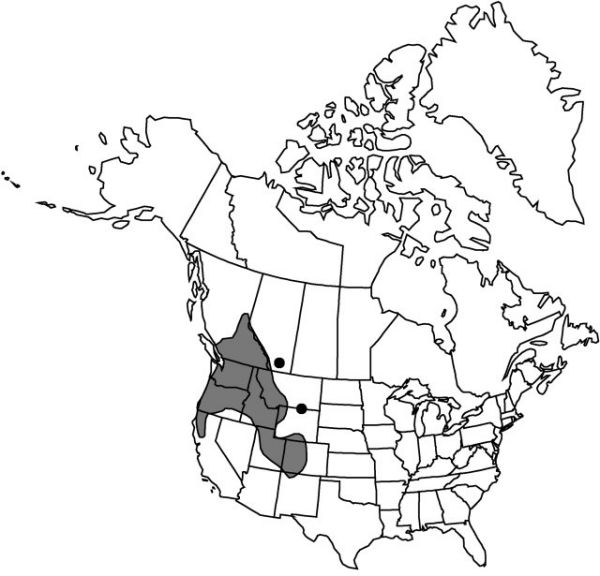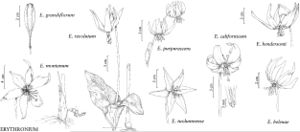Erythronium grandiflorum
Fl. Amer. Sept. 1: 231. 1814.
Bulbs slender, 30–50 mm. Leaves 5–20 cm; blade green, lanceolate, ± glaucous, base gradually narrowed to petiole, margins ± wavy. Scape 5–30 cm. Inflorescences usually 1-flowered, sometimes up to 5-flowered. Flowers: tepals recurved, bright-yellow with (in live specimens) narrow paler zone at base, or white to creamy white with yellow base, narrowly ovate, 20–35 mm, length at least 4 times width, inner usually auriculate at base; stamens 11–18 mm; filaments white, ± slender, linear, less than 0.8 mm wide; anthers cream, yellow, red, or purplish red; pollen yellow or red; style white, 10–15 mm; stigma unlobed or with slender, recurved lobes (1–) 2–4 mm. Capsules oblong to narrowly obovoid, 2–5 cm. 2n = 24.
Distribution

w North America
Discussion
Subspecies 2 (2 in the flora).
This beautiful species is often very abundant in mountain meadows of western North America, especially in the Rocky Mountains, where it may form spectacular displays. It is often difficult to grow in cultivation outside its preferred habitats. Bulbs of this species were a staple food for native North American peoples of several tribes, and were eaten in large quantities and also traded. Within the typical subspecies, both anthers and pollen vary considerably in color; plants with pale anthers have been called var. pallidum, and forms with yellow anthers, var. chrysandrum. Plants possessing very short stigma lobes and lacking auricles on the tepals have been recognized as var. nudipetalum, but they do not appear sufficiently distinct to warrant taxonomic recognition and may simply represent depauperate forms.
Selected References
None.
Key
| 1 | Tepals white to creamy white, with yellow zone at base; anthers cream to yellow. | Erythronium grandiflorum subsp. candidum |
| 1 | Tepals bright yellow, with narrow paler zone at base; anthers cream, yellow, red, or purplish red. | Erythronium grandiflorum subsp. grandiflorum |
"broad" is not a number."thicker" is not a number.
